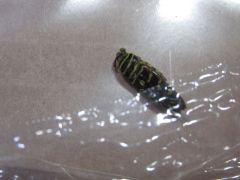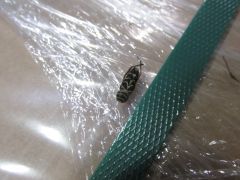Need help identifying immigrating bugs
Hi
Can anyone from Europe tell me what these little guys are? If you click on the picture it gets bigger. They came in on an imported pallet. I gave some to my pest control company to identify, but they were not able to tell me what they were, only that they were not native. I kept the pallet segregated on our loading doc (our receiving manger was too afraid of purchasing to reject it, so that's a whole other corrective action), but I'm concerned if they laid eggs or something our factory will get infested. We don't have outside storage either! And it's worth lots of money, so they won't let me throw it out, even though we'll probably end up destroying it or sending it back. Maybe someone will tell me it's really dangerous and will destroy our eco system, like frogs in Australia.
Can you narrow location down a bit?
Looks vaguely wasp/bee-like.
Can you narrow location down a bit?
Belgium....the kind of looked like crickets or grasshoppers?
Do you have a pest control company? They should have an entomologist that could determine exactly what pest it is.
My vote is that it is a locust borer that could have been picked up on its travels cross country. http://en.wikipedia....yllene_robiniae
My vote is that it is a locust borer that could have been picked up on its travels cross country. http://en.wikipedia....yllene_robiniae
Oh, that looks just like him! You're amazing!
Do you have a pest control company? They should have an entomologist that could determine exactly what pest it is.
I did send it off, they couldn't identify it immediately, so they were going to send it off again somewhere else. They said I should know by tomorrow, but that's so far away! And my purchasing department is refusing to contact the vendor to complain until I can identify the bug (because getting an infested ingredient is okay if you know what it is?). This is the same vendor and purchasing agent as this incident - http://www.ifsqn.com...ndor-complaint/
If I didn't know any better I'd say that vendor is paying our purchasing dept's salary. So I gotta have enough information to really go in there guns blazing. (cocked and ready with the species ammo now) Still have to decide if being able to complain to vendors about INFESTED disgusting product is the sword I want to die on here. But it's unacceptable to receive something covered in these, even if they are just little southerners who munch on pretty trees.
Oh, that looks just like him! You're amazing!
Some days I'm the bus.....some days I'm the road.....was nice to be the bus :sorcerer:
That sight is amazing Snookie!!!
Adults lay their eggs in locust trees in the fall. Later the larvae will hatch and spend the winter hibernating within the bark. Once winter ends, the larvae will burrow into the tree trunk and start to tunnel. These tunnels are around 10 cm (4 inches) long by 7 mm (0.25 inch) wide. The larvae will then pupate in late July and early August. The adults will start to emerge in late August and throughout September.
So if I receive a pallet from you M_M I should start seeing them around August thru September????
My vote is that it is a locust borer that could have been picked up on its travels cross country. http://en.wikipedia....yllene_robiniae
Feel better now that YOU have a best answer? :giggle:
Bugs. Ugh.
:eekout:
Feel better now that YOU have a best answer? :giggle:
A little.. :roflmao:
Hi,
perhaps could be also Clytus arietis or Plagionotus arcuatus.
Both are living within Europe. But also they are living within the woods. I had also once a delivery with other wood boring beetles. We have found them dur to small hills of eaten wood on the pallets. Some of them have bored through the slip protection, through the cardboard of the boxes, and totally frustrating through plastic bag into the product. After checking and recognizing this we did reject the delivery. I have never expected they would start to eat or pass plastic bags.
Keep an eye on that before they start to spread within the warehouse.
Yours
Werner
Attached Files
Hi,
perhaps could be also Clytus arietis or Plagionotus arcuatus.
Both are living within Europe. But also they are living within the woods. I had also once a delivery with other wood boring beetles. We have found them dur to small hills of eaten wood on the pallets. Some of them have bored through the slip protection, through the cardboard of the boxes, and totally frustrating through plastic bag into the product. After checking and recognizing this we did reject the delivery. I have never expected they would start to eat or pass plastic bags.
Keep an eye on that before they start to spread within the warehouse.
Yours
Werner
:yikes: I will keep an eye on them, that thing is the last of "things I want".

